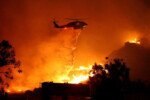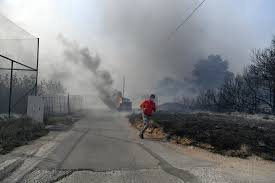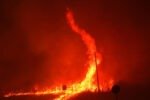California faced other weather threats as an oppressive heat wave strained the state power grid and moisture from a tropical storm threatened to unleash thunderstorms and floods
LOS ANGELES, Sept 9: Firefighters on Friday struggled to control raging California wildfires that have grown explosively during extreme heat and forced thousands of residents to flee mountain communities at both ends of the state.
The Fairview Fire in Southern California covered about 37 square miles (95 square kilometers) of Riverside County and was just 5% contained. Two people died while fleeing flames on Monday and at least 11 structures have been destroyed. More than 18,000 homes were threatened by the fire fed by shifting winds, officials said on Thursday evening.
To the north in the Sierra Nevada, the Mosquito Fire burned out of control, scorching at least 20 square miles (52 square kilometers) and threatening 3,600 homes in Placer and El Dorado counties, while blanketing the region in smoke.
Flames jumped the American River, burning structures in the mountain hamlet of Volcanoville and moving closer to the towns of Foresthill, home to about 1,500 people, and Georgetown, population 3,000. Fire spokesperson Chris Vestal called the fast-moving blaze an “extreme and critical fire threat.”
Stefani Lake evacuated her hilltop home near Georgetown Thursday after sheriff’s deputies knocked on doors telling people to get out. “The dogs are in the back of the car, I’ve got a room for the night, so I’m ready to leave,” Lake told the Sacramento Bee.
About 100 miles (160 kilometer) to the east, the Nevada Division of Environmental Protection warned the Reno area that air quality could be very unhealthy to hazardous due to smoke from the Mosquito Fire.
The fire’s cause remained under investigation. Pacific Gas & Electric notified the state Public Utilities Commission that the U.S. Forest Service placed caution tape around the base of a PG&E transmission pole but that no damage could be seen. PG&E said unspecified “electrical activity” occurred close in time to the report of the fire on Sept. 6.
Another dangerous blaze burned in stands of timber near the Big Bear Lake resort region in the San Bernardino Mountains east of Los Angeles. It was just 2% contained after scorching nearly 2 square miles (5 square kilometers).
California faced other weather threats as an oppressive heat wave strained the state power grid and moisture from a tropical storm threatened to unleash thunderstorms and floods.
A surge of clouds and showers associated with Tropical Storm Kay off Mexico’s Baja California peninsula knocked the edge off temperatures in Southern California at times but also were a potential problem for solar generation. The storm was downgraded from a hurricane Thursday evening.
Despite the initial impacts of Kay, forecasters warned that the heat was not yet done.
“The seemingly endless heat wave that has been plaguing California will finally becoming to an end across at least Southern California, but not before two more very hot days and very warm nights,” the Los Angeles-area weather office wrote.
Operators of California’s power grid issued another “Flex Alert” call for voluntary cuts in use of electricity and expanded the period by two hours, 3 p.m. to 10 p.m. The alert expired Thursday night without the need for targeted blackouts to ease the stress on the power grid.
Wildfire smoke and the cloud cover created uncertainty about solar power production in afternoon hours when temperatures rise toward their peaks, said Elliot Mainzer, president and CEO of the California Independent System Operator.
Cal-ISO has issued Flex Alerts since last week and has avoided ordering rolling power outages, although a miscommunication with one Northern California provider led to blackouts.
With record demand on power supplies across the West, California snapped its record energy use around 5 p.m. Tuesday with 52,061 megawatts, far above the previous high of 50,270 megawatts set July 24, 2006.
An emergency appeal for conservation that was sent to Californians’ cellphones was credited with an immediate drop in demand on the electrical grid Tuesday evening.
Storm and wind conditions associated with the approaching hurricane were likely to create a new set of risks for power shortages in Southern California, he noted.
Kay was expected to reach northern Baja California on Friday, the National Weather Service said. Despite losing hurricane strength, Kay was expected to send a surge of moisture into Southern California. Strong winds, heavy rain and flash floods were likely Friday evening through Saturday. Tropical storm warnings were posted for mariners.
Up the West Coast, forecasters predicted strong, gusting winds and low humidity across western Oregon beginning Friday and authorities warned of heightened wildfire danger after an unseasonably hot and dry late summer.
An Oregon utility said it will cut power to about 12,500 customers to the south and west of Portland in anticipation of strong, dry winds that pose a severe wildfire danger in the region. Another utility says about 30,000 additional customers could see their power cut as well in a bid to prevent fire from sagging or broken power lines. AP







